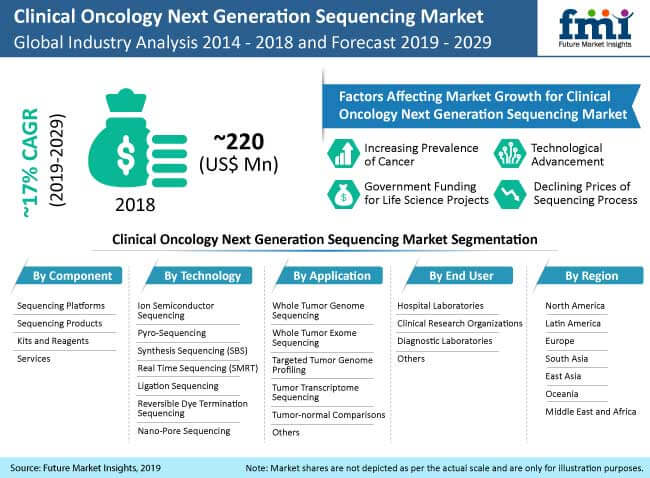
The Clinical Oncology Next-generation Sequencing Market will observe a growth of 17% CAGR by 2029
Next-generation sequencing refers to the identification of the nucleotides of DNA base pairs for the diagnosis of various diseases. Oncology is one of the important applications of next-generation sequencing. It is an advanced and faster method of sequencing. Clinical oncology next-generation sequencing includes kits & reagents, services, sequencing platforms, and sequencing products. The kits and reagents used for sequencing are expected to witness significant growth in the overall market.
North America is expected to be a prominent region in the global clinical oncology next-generation sequencing market owing to the presence of well-developed healthcare infrastructure and numerous technological advancements in the region. North America and Europe are expected to witness a significant growth rate in the clinical oncology next-generation sequencing market.
Synthesis Sequencing Technology to Hold a Major Market Value Share
Based on the technology, the clinical oncology next-generation sequencing market has been segmented into pyro sequencing, sequencing by synthesis (SBS), and Single-Molecule Real-Time Sequencing (SMRT), nanopore sequencing, ligation sequencing, and reversible dye termination sequencing. Synthesis sequencing is however expected to hold a significant share in the clinical oncology next-generation sequencing market. Ion semiconductor sequencing is a method of DNA sequencing in which hydrogen ions are detected based on the polymerisation of DNA. Pyro-sequencing includes identifying the order of nucleotides in DNA based on the “sequencing by synthesis” principle, in which the sequencing is performed with the help of DNA polymerase. SBS is a technique used to determine the series of base pairs in DNA, which is also known as DNA sequencing.
Download Sample Copy @ https://www.futuremarketinsights.com/reports/sample/rep-gb-9543
There are various applications associated with clinical oncology next-generation treatment market. They include whole tumor genome sequencing, whole tumour exome sequencing, targeted tumour genome profiling, tumour transcriptome sequencing, tumour-normal comparisons, and other applications. Targeted tumor genome profiling is expected to hold a large share of the clinical oncology next-generation treatment market. On the basis of end user, the clinical oncology next-generation sequencing market has been segmented into hospital laboratories, clinical research organisations, diagnostic laboratories, and others. Clinical research laboratories are expected to hold a large revenue share in the clinical oncology next-generation sequencing market.
Apart from the factors driving the clinical oncology next-generation sequencing market, there are few factors that are likely to hinder the overall growth of the clinical oncology next-generation sequencing market, such as high costs associated with the establishment of sequencing platforms, low quality of outsourcing services, and inadequate availability of sequencing platforms in some regional markets. On the other hand, increasing biomedical research using clinical oncology, increasing government funding for life science projects, substantial decline in the prices of sequencing, and technological advancements in the field of sequencing are some of the major factors driving the growth of the clinical oncology next-generation sequencing market.

Tier 1 Companies Hold Nearly 3/5th Share of Global Market Value
The report tracks some of the key companies operating in the clinical oncology next-generation sequencing market such as QIAGEN N.V., Thermo Fisher Scientific., Pacific Biosciences of California, Inc., F. Hoffmann-La Roche Ltd Oxford Nanopore Technologies, Ltd., Takara Bio, Inc., Illumina Inc., PerkinElmer Inc.and Agilent Technologies, Inc. Thermo Fischer Scientific, Oxford Nanopore Technologies Ltd., and Illumina are expected to hold a signficant share of the clinical oncology next-generation sequencing market. These first tier companies hold a share of approximately 60% in the clinical oncology next-generation sequencing market.
Ask the Analyst @ https://www.futuremarketinsights.com/ask-question/rep-gb-9543
Table of Content
- Executive Summary
1.1. Global Market Outlook
1.2. Analysis and Recommendations
- Market Overview
2.1. Market Coverage / Taxonomy
2.2. Market Definition / Scope / Limitations
- Market Background
3.1. Macro-Economic Factors
3.2. Forecast Factors – Relevance & Impact
3.3. Market Dynamics
3.3.1. Drivers
3.3.2. Restraints
3.3.3. Opportunities
3.3.4. Trends
- Key Success Factors
4.1. Cancer Epidemiology, By Region
4.2. Key Regulations
- Global Clinical Oncology Next Generation Sequencing (NGS) Market Value (US$ Mn) Analysis 2014-2018 and Forecast, 2019-2029
5.1. Historical Market Value (US$ Mn) Analysis, 2014-2018
5.2. Current and Future Market Value (US$ Mn) Projections, 2019-2029
5.2.1. Y-o-Y Growth Trend Analysis
5.2.2. Absolute $ Opportunity Analysis
- Global Clinical Oncology Next Generation Sequencing (NGS) Market Analysis 2014-2018 and Forecast 2019-2029, by Component
Editor Details
-
Company:
- MARKITWIRED
- Website:
